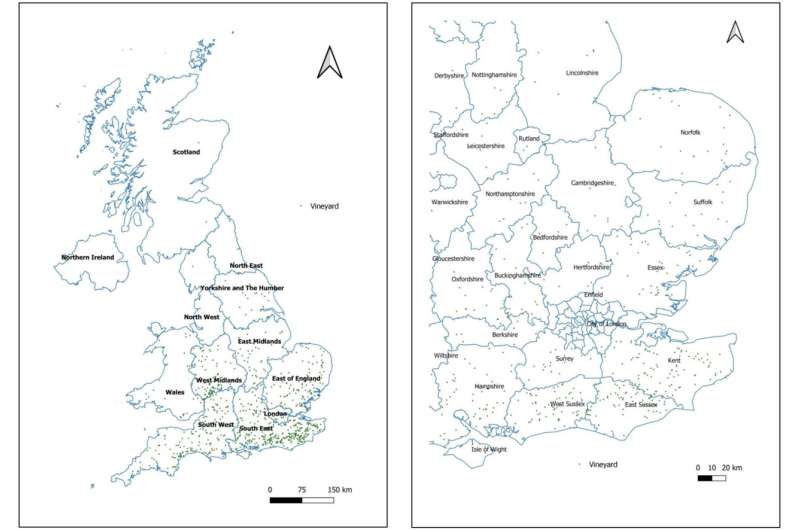Location of vineyards in relation to administrative regions of the UK (left panel) and the counties of East of England, East Midlands and South East England (right panel, with Greater London’s Enfield and City of London also marked). Location of vineyards as of 11 November 2020 from Skelton (2020b). Credit: OENO One (2022). DOI: 10.20870/oeno-one.2022.56.4.5458
The impact of climate change by 2050 may mean that UK-grown Chardonnay grapes will be ripe enough to produce high quality still wines, in most years.
Following their model of the effect of variation in weather on Chablis wine quality, in France, researchers at the University of Reading have turned their attention to Chardonnay still wine production in the UK. Their work is published in OENO One.
Alex Biss, a Ph.D. student who led the project, said, "There are some great sparkling wines produced from Chardonnay grapes already in the UK, but the grapes used in sparkling wines don't need as much ripening as for still wines. A good Chardonnay vintage is not attained reliably in Britain at present, but climate change looks set to change that in the not too distant future."
The research model, developed by Biss and professor of crop science, Richard Ellis, considered three aspects of weather that affect the quality of Chardonnay still wine: mean temperature between April and September, mean minimum temperature in September ("cool night index"), and total rainfall between June and September. The model identified 20 to 25% of UK land may be suitable by 2050. This compares to the current situation of only 2% of UK land.
Biss said, "UK temperatures and rainfall in favorable regions will be aligned to produce consistently good Chardonnay wine by the middle of the century in most years."
"There are of course unknowns. Just because a region has a suitable climate, it doesn't mean that it has the right sort of land for growing vines. But the fact remains that climate change will very likely bring a further expansion of viticulture in the UK."
Areas most likely to have the best conditions for producing high-quality still Chardonnay wine reliably by 2050 include South East England, East of England, and Central England.
The RCP 4.5 pathway was selected to provide climate projections. This is an intermediate greenhouse gas emissions scenario in which climate policies can limit global temperature rise to between 2 °C and 3 °C by 2100. Under this scenario, emissions continue to rise until around 2040, and then decline.
Biss said, "We are not celebrating global warming, which for so many is already causing major challenges to food production, public health, and more. Rather, it's something that we must monitor and respond to by changing what we grow, and where. The immediate implication of our findings is that UK viticulturalists establishing new vines, in the areas above, should consider planting dual-purpose Chardonnay clones suitable for both sparkling and still wine production."
More information: Alex J. Biss et al, ES Weather potential for high-quality still wine from Chardonnay viticulture in different regions of the UK with climate change, OENO One (2022). DOI: 10.20870/oeno-one.2022.56.4.5458. oeno-one.eu/article/view/5458
Provided by University of Reading
























